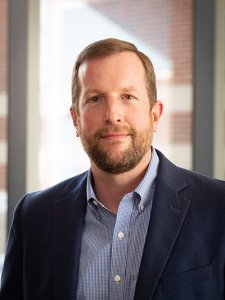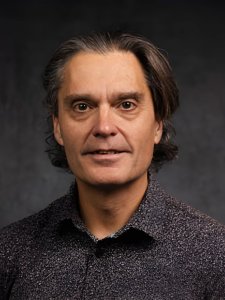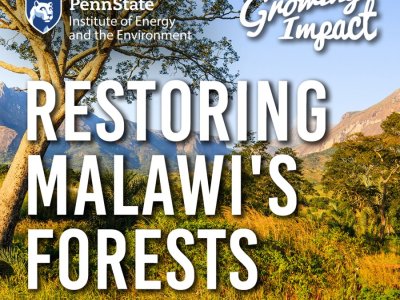25-minute listen/watch | 15-minute read | 1-minute teaser
PFAS, synthetic chemicals found in countless everyday products, have made their way into humans and animals around the globe. Although their health effects remain unclear, their widespread presence raises important questions. Scientists are now investigating whether these chemicals might disrupt the human gut microbiome, potentially impacting our health in unexpected ways.
Transcript

Andrew Patterson
Persistent chemicals are perhaps transiently or maybe even permanently altering the microbiome, depending on the exposure window. So, one of the big questions people have is, if you're exposed early on in life, you know, at birth, does this perhaps set you up in the wrong trajectory, if you will, health-wise?
Host
Welcome to Growing Impact, a podcast by the Institute of Energy and the Environment at Penn State. Each month, Growing Impact explores the projects of Penn State researchers who are solving some of the world's most challenging energy and environmental issues. Each project has been funded by the Institute's seed grant program that grows new research ideas into impactful energy and environmental solutions. I'm your host, Kevin Sliman.
Perfluorinated substances, also known as PFAS, are manmade chemicals found in a wide variety of everyday items. They've been around since the 1940s, and widespread detection and public awareness increased significantly around the turn of the century. There is growing evidence of links between PFAS exposure and various health effects, and these forever chemicals can now be found in many living creatures, including humans.
On this episode of Growing Impact, we discuss a past seed grant on environmental contaminants through which researchers have continued to develop new areas of investigation. One of the important questions raised by this team of researchers is: do PFAS impact the human microbiome, which are the microorganisms that live in a human's gut? And if so, what's the impact?
Hello, Andrew. Hello, Costas.
Andrew Patterson
Hey, Kevin, how are you?
Costas Maranas
Hi. How are you?
Host
I'm doing great. Thanks so much for being on Growing Impact and discussing your research. Could each of you take a moment and introduce yourselves? Can you tell us your name, your title, and provide a brief background on your research?
Andrew Patterson
I'm Andrew Patterson. I'm the John T. and Paige S. Smith Professor in the College of Agricultural Sciences. My home department is the Department of Veterinary and Biomedical Sciences. I've been here at Penn State now since 2011, and my research really focuses on the chemical communication between the hosts — in most cases, mouse models, but also humans — and their microbial partners, so their microbiomes.
We've been really active in this area trying to, you know, dissect how we communicate with those microbes and vice versa. And so this has been the central focus of our research for, you know, the last 13 years or so and hence kind of the strong connection that I've had with Costas to really focus on kind of this important question, and that is around how microbes are utilizing substrates that the host provides and vice versa.
Costas Maranas
So my name is Costas Maranas. I’m the Donald B. Broughton Professor of Chemical Engineering. And my home department is the Chemical Engineering Department. And, our research work straddles the world of biotechnology, biophysics, and biochemistry with the world of computational optimization and algorithms. So what we are trying to do is figure out ways of making metabolic pathways more in tune with your biotechnology objectives, finding ways to engineer enzymes to do appropriate bioconversions, engineering antibodies so they recognize specific pathogens, et cetera.
Everything that we do in our group is computational. So, we are partnering with other labs, either at Penn State or elsewhere, to help us support our investigation.
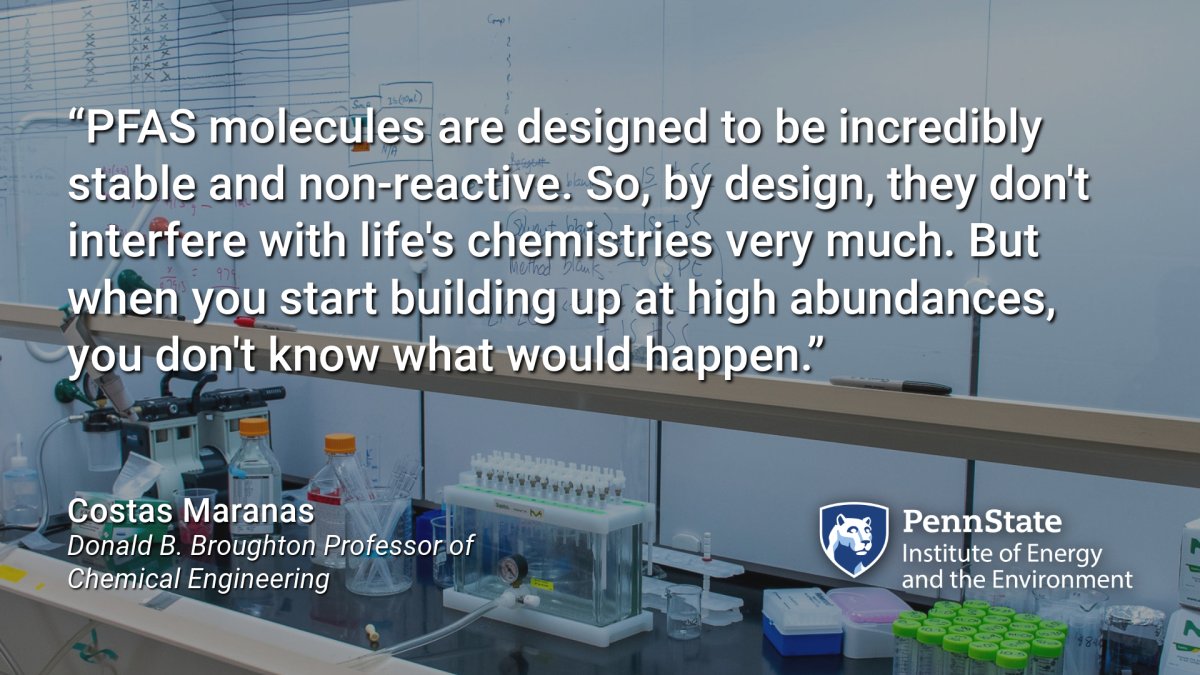
Host
Your work on environmental contaminants and their impact on human health has continued to grow. Can you tell us about the start of this effort and what inspired you to research the subject?
Andrew Patterson
When I first came here to Penn State, one of my big interests has always been on understanding how chemicals that we're exposed to impact us. And we had really only ever focused on this from the host perspective. So, really thinking about this, you know, how do these chemicals impact us directly? But during my postdoc, when I was with Frank Gonzalez at the National Cancer Institute, we had some hints that it was impacting other things, like the microbes that resided in us.
But we really didn't have a lot of the tools and technology and more importantly, the expertise to really investigate this in a lot of detail. So that was one of the very first things I did when I got here to Penn State was to do some basic sequencing experiments back... this is now, gosh, probably right after I got here. So, 12, 13 years ago. And that was to look at the community changes that were occurring after this exposure to — in this case, it was a different drug. It was not an environmental contaminant. But, we very quickly saw that there was a big impact on the composition of the microbes, in this case, in the guts of mice. And that very quickly led us to try to focus on what that meant functionally.
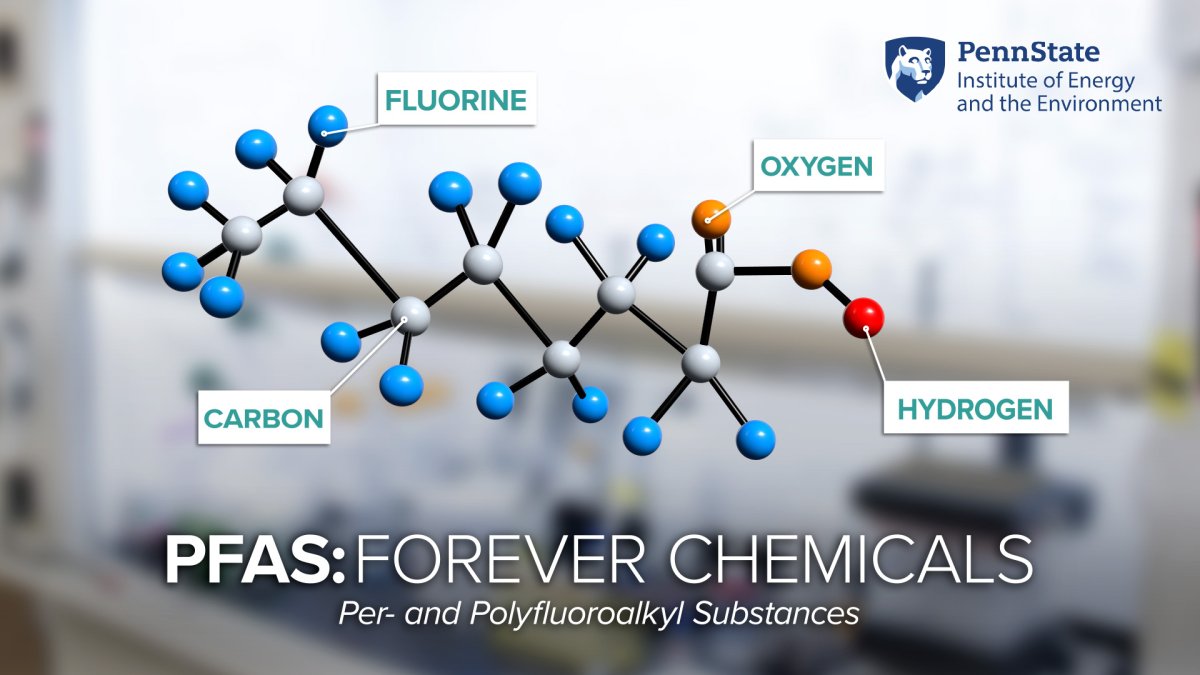
And so we started combining what is, what I would say is our lab’s expertise and that's metabolomics. And so this is just a way of comprehensively profiling all the small molecules that are in a sample. So glucose, TCA cycle intermediates, bile acids, that sort of thing. And from there we began to expand upon, you know, any other different type of chemical that we may be exposed to.
And so because we're in the Institute of Environment and Energy [sic], one of the things that we've been focusing on was, you know, thinking about these environmental chemicals, PFAS, perfluorinated species were on the, you know, on everyone's radar, even now more than ten years ago. And now currently, it's, you know, hugely important. But beyond that, also looking at other environmental chemicals, persistent ones: dioxins, virions, PCBs, these types of chemicals that we know to be exposed to on a daily basis.
And one of the big things we began to wonder was how is this impacting, you know, this other important thing at the time, was the microbiome. And I think it was relatively new. And so that's really what, you know, kind of sprung the whole interaction.
Host
So the contaminant at the time you already mentioned was the PFOA. I don't know if everyone's familiar with that as PFOA, but under that PFAS kind of terminology, could you tell us a little bit about it and maybe you know where it's used and what it's used for, maybe where it shows up.
Andrew Patterson
Over the last several years, we've been reading a lot about it. And just the, you know, general, you know, newspapers, magazines, because it's been showing up in humans at fairly reasonable levels. I don't think we have a good understanding of where, at what level of the toxicity occurs. There's certainly some concerns about it because, you know, they would not expect them to be, you know, as pervasive throughout humans.

But also, I would say probably fairly easy to say that any organism on Earth probably has some level of these chemicals residing in them. So where do they come from? You know, anything that's going to be used for water repellents, plastics, anything like our cell phones, all of these things that we utilize in our day to day lives require these chemicals, you know, for their production.
Certainly. I think there's a big wish to move away from them in terms of you know, waterproofing and that sort of thing, you know, nonstick, all that sort of stuff as well. But the problem is that they're really persistent in the environment. They don't break down as readily. And so I think that's why we've been seeing them in, you know, in our bodies over the last... I think it's a question about when it's been probably many decades. I think that we know that they're there. And, you know, there's been a lot of work to show that samples collected prior to their production, you know, nothing is there. So this isn't some accident of the, you know, nature. This is clearly an activity of humans.
So they've been, huge efforts now to comprehensively profile them. So this now, you know, I think where people are just looking at a few so PFAS, PFOA. Now there's, I don't even know what the number is now, but probably dozens. And they're metabolites too. So I think that's raised a lot of questions. And then, you know, I think there's a lot of issues with, you know, if we try to think about these as being foreign chemicals, you know, we should probably keep them, you know, to almost zero levels in us.
And the fact that now pretty much everybody on Earth has them, and they're finding them in places that are so remote, you know, this is just being shown that they're being carried, you know, by a variety of different, you know, atmospheric processes, that sort of thing. It's raised a lot of concern. And the question then is, you know, what are the long-term health implications of this?
And I think the I don't think there's been a clear connection yet. A lot of it's been done through animal models. And then of course, maybe through epidemiological studies. But the you know, I think this is, you know, something that we'll, we'll begin to figure out here in the next, you know, few years about what this, what this means long term.
And I think that, you know, the question about people are certainly afraid of it. So, I think we just got to figure out what it really means in terms of, you know, are these exposures causing problems or not? I don't think we really know the answer to that yet or not.
Host
How does PFOA impact human health? So, it's still an unknown at this point. There are conjectures, right? There's theories and models that maybe are out there, but there's no clear evidence. Am I understanding that correctly, on how it affects humans?
Andrew Patterson
Yeah, I'd say it's not totally murky. I think we have a sense that there's some impact. What I don't think is clear is like the exact mechanism by which things may cause harm. And more importantly, I think with respect to toxicology is an understanding of, you know, what the dose is and what a typical dose is for you and I, and how that actually translates into what we would consider, you know, something that would cause toxicity.
So, you know, this has always been a big, you know, central tenet of toxicology, and that's, the dose makes the poison. And so it's something I think we need to wrestle with. But I think I would go as far as to say we're just not exactly 100% sure of what these long-term health implications are.
Costas Maranas
There is some epidemiological evidence that tends to increase disease outcomes, but again those are only epidemiological data with plenty of compounders. You that people that people are exposed to PFAS earlier and exposed later to industrial poisons. So the question is, you know, as Andrew mentioned, what is the cause of this mechanism? And we don't, to my knowledge, we still don't know that. Those molecules are... So they are by design, they don't interfere with life's chemistries very much. But of course, when you start building up at high abundances, you don't know what would happen.
Andrew Patterson
Yeah. And I think the big question is, is that it's hard to pinpoint one chemical is causing the problem. So as Costas said, you know, it's much more complicated because we are exposed to, you know, it's a mixtures problem. And so, what do all those mixtures of chemicals actually do? And is the mixture that I'm exposed to similar to what you guys may be exposed to.
And it could just it could be specific to the individual being, you know, that the exposure’s occurring to. And of course, all the other things, you know, the big one is, of course, you know, diet, health, you know, or exercise. All of these other factors play an important role in this. And so we're, you know, trying to disentangle that. It's easy to do in mice, right? Because we can control them really easily. We know what we feed them. We know how active they are. We can even control, you know, some of those aspects relatively easily. But for, you know, your free-ranging human, it's really challenging to do.

Host
How have you seen this effort grow and mature since it started? Again, we're looking back like a decade. Some of the things that have changed and/or grown?
Andrew Patterson
Yeah, I think one of the interesting observations we made early on with this and in a variety of other environmental contaminants, was their impact on bile acid metabolism. So these are molecules that, you know, if we look in our textbooks, are important for fat solubilization after you eat a meal. But what we quickly realized was that, you know, these were a good readout of changes in microbial activity, enzymatic activity in particular.
And that was one of the questions I actually had brought up to Costas's group was, you know, we can see these changes occurring in the bile acid pool. In particular, we could see changes in the way bile acids are decorated with different amino acids. And so one of the things we began to wonder was, “Why? What is it, what is going on here?” And for probably decades, people just thought this was a way to reduce their toxicity. So the microbes deconjugate, they’re removing of amino acids from them, in this case glycine or taurine, and the big question was, well, why?
And I couldn't really get a clear answer from that by looking in the literature. So then I had talked to Costas about this. And Costas, I believe it’s Joshua that... is that right?
Costas Maranas
Joshua Chan. Yes. My former postdoc. He's now an assistant professor at Colorado State.
Andrew Patterson
Yeah. So we started working together to try to figure out what this meant. And actually through this collaboration, Joshua was able to find out, you know, some really interesting hypotheses that were outside of kind of the toxicity question. So really having to do with perhaps that, you know, the microbes could utilize these as energy sources. And I think that was where it very quickly, you know, morphed into this, you know, understanding of like how our microbes are then responding to these changes, and then more importantly, how can we model this?
And that was really hard. I mean, it's not something my group is at all familiar with, but the expertise that we had, you know, with Costas’s group, really allowed us to address this question, and then, Costas, I actually, I think it was after this paper, then we worked with Gary Wu more on that neonatal thing. And this is again, the same type of thing, like how do we begin to integrate the changes that we see in the microbial community from, say, just like if we're just counting who's there versus what we see when we measure their metabolites through metabolomics. We didn't have a really good way of integrating that data.
And that's where, you know, our interaction, collaborations with Costas’s group had a huge impact because that started to allow us to put these pieces of the puzzle together in a way that actually, you know, made some, some sense. So that was really, you know, tremendous, you know, finding that we found through, you know, this collaboration, I think that's, you know, kind of where things have gone from this initial seed grant.
Costas Maranas
Yeah. And Joshua, he did very nice work. He developed metabolic models for many of the participants in the microbiome, many of the microbes that are present there. And he asked the question, which carbon molecule could be consumed by one microbe? And then he ended up generating hypotheses as to, you know, who's consuming what carbon molecule, and why.
For what purpose. And he continued on the same path of modeling microbial communities. And right now, he's running his own lab. He's an assistant professor at Colorado State. So, I think that had an impact on his career.
Host
Where is this seed grant led you, and can you share some success stories?
Andrew Patterson
You know, this work that Joshua, helped us with, you know, obviously led, you know, to in part to his landing a faculty position. We also published a number of papers, one was in M Systems. We subsequently, Costas and I, then focused on more around the, in this case, not so much the environmental contaminant aspect, but focusing on more of the mechanism of how the microbes interact with host metabolites.
So we wrote a grant with some partners at NIH to look at in this case, this is a more basic question, around how this whole interaction occurs. So that was a win for us. And I think now coming full circle, we started working back on some of this perfluorinated work. And because of some of the insights we had originally, now we have some really amazing observations.
It raises some important questions. And that is that: is this exposure to these perfluorinated chemicals shifting our microbiome in a way that may be good or bad. We don't know. I'm not saying that it's a health benefit of this exposure. But we don't really necessarily know what the change in the composition of that community may make you susceptible to certain things like inflammatory bowel disease, right?
This is hugely problematic here across the westernized world. And so exposure to things like this could trigger this. And I think this is something that, from a toxicology standpoint, we've not really fully considered over the last, now, I'd say, many decades thinking as microbes as targets or toxicity endpoints. You know, there's no like... I can look at my, you know, toxicology textbooks and there's no section on the microbiome. I mean, I think this is something that probably will be added because now we appreciate that this is really important. And we need to have a better understanding for how this whole interaction occurs. And I think this is, which is super exciting about the field right now.
Host
What are some next steps for the research and maybe looking at things that you're either excited about or even maybe some challenges?
Andrew Patterson
Yeah, I mean, I think the as I alluded to before, I think one of the things that we're really interested in is thinking about how these persistent chemicals are perhaps transiently or maybe even permanently altering the microbiome, depending on the exposure window. So one of the big questions people have is if you're exposed early on in life and at birth, does this perhaps set you up in the wrong trajectory, if
And there's been a lot of evidence with that, with antibiotics. So antibiotic exposure. Right. So that's you know, they know there’s good evidence to show that this causes problems. The same can be true for these chemicals. Right? So, you know, they could be, you know, bactericidal, bacteriostatic and they can have the same properties or, you know, we may not be taking them for therapeutic purposes, right. But if they're manipulating or altering the community in a way that sets you up in a, you know, kind of in a problematic way. I don't want to say dysfunctional because I don't really, it's hard to say what that actually means, but it is perhaps a contributor to some of our more modern health problems. I mean, I think that's, you know, something that people are trying to tease out.
So, I'm excited about that because I think here at Penn State we have the tools to do this. We now are doing really cool imaging studies to look at the individual bacteria themselves. This is something I never really would have thought to do, but was only, I only learned about it through talking to someone at a networking thing one time where we were just sitting around talking about projects and they said, oh, you should try this.
So that's something that we've begun to explore now that's actually trying to image bacteria and to see what happens to them after certain exposures. And so you can do this by mass spec imaging now. There's other but there's other platforms to do that. So I'm super excited about that. And I think, you know, because we have all the right connections, and we can, we have a track record of doing good stuff with everyone here.
So I think that's, really sets everyone up for success. And I gotta say, I think the big thing is the excitement really builds around seeing the students get excited about their projects. I mean, I can speak for myself, maybe Costas will agree, is like most of the time I spend in my office, not doing very much in the lab at all. And but to hear them come in and share something exciting, I mean, I think that's probably the best, you know, most rewarding aspect of our jobs is to see them get excited about stuff.
Costas Maranas
Yeah. Ultimately, the students drive the projects where they are to offer the occasional good idea. But, you know, they are the ultimate drivers of success or failure in all of those collaborations.
Host
How did early support from IEE enable success in this project?
Andrew Patterson
One of the things that they were really adamant about was that you worked with someone outside of your college. And so that was, I think, another reason why Costas and I ended up working, too... not just because of that reason, but I think that's made it a good fit. And, you know, I think that that really gave us, kind of provided us a really good complementary collaboration where, you know, we brought really both groups brought a lot of strengths to the table.
And because of that kind of caveat that was within the IEE solicitation, I think that was great. I mean, perhaps maybe there was some luck involved that we that we just happened to work together at the right time. But I think because of that push, you know, that was that was really helpful. And I think that's something that IEE is still championing.
And I think other institutes, the Huck, for example, I know that they really favor that a lot, making sure that you're not just sticking to your home department, but that you're working outside of that. And I'm personally it's just something that I really embrace. You know, through our work as well, because I know that we're not experts in, you know, everything and that we do need help for doing things. And I think that makes things really fun, that makes research, you know, really enjoyable.
Host
Was there something that was surprising to you during this process that you, you know, learned or discovered?
Andrew Patterson
I think one thing that's come from just this general question is that how... it's probably a no-brainer to Costas, but to me it has been. And that was that how incredibly... what good chemists microbes are. It's remarkable what we see. And in fact, a lot of the things that we measure in our mass specs, you know, we can't annotate because they're not in some library, but we have a really strong feeling and maybe even a good appreciation that a lot of what we're seeing is not through host-mediated mechanisms, but probably through microbial. So I would say that's been maybe the biggest surprising thing. You know, to me.
Costas Maranas
Yeah, microbes do bring to bear so many more enzymes than the host has, mammalian host has. So, yeah, if you think of it in that light, it’s not surprising. You think of a pound or so of microbes produce so much. But every single one comes in with its own armory of metabolic functions and enzymatic functions. And my feeling is that we only understand part of them. I think we start seeing compounds when you do your MS, that you have no pathways that can explain them. So clearly, there is more chemistry that they can do than we know at this point.
Host
If you had 20 seconds, you're in an elevator with a U.S. senator, you got to pitch this project because you think it's the next best thing and you want them to champion it. What's your elevator pitch for this?
Costas Maranas
Is it going to be an 80-year-old senator? If that’s the case, then I will tout the potential of this work towards extending lifespan by manipulating the microbiome in their gut and understanding how that can have age prolongation effects.
Andrew Patterson
Yeah. And I guess, I mean, I would echo the same thing. I think that, you know, there's a lot of opportunities for drug development, you know, trying to understand how they may be producing important drugs because they produce, you know, chemicals that manipulate us really, really well. There's lots of evidence of this.
And so if we can tap into that and get a better understanding for how this occurs, you know, there's, you know, huge rewards there from a, you know, therapeutic standpoint to promote our health and reduce disease. And I think ideally improve nutritional outcomes, you know, trying to understand, you know, what we're feeding us, in addition to our microbes. Like how does that impact overall health? So I think that's another key component there.
And we didn't touch on today but is nutrition and diet. You know, diet plays a huge role in shaping our microbial community. And so if we can get a better sense of how that's working, you know, I think that this could have really profound implications for, you know, human health. There's a lot of people studying some of these long-lived Japanese individuals who, by and large, live perfectly healthy lives well into their, you know, early hundreds. And so why is that? And one of the things, one of the tantalizing things is is that this is a contribution of the microbes, preventing them from some really, you know, problematic diseases. It's interesting. Certainly, there's a lot to be learned. And I think, you know, like I said earlier on, that's good for us because it just means that there's more things for us to continue to work upon.
Host
Thank you for taking time and speaking with us. So, Costas, Andrew, it was a great conversation.
Andrew Patterson
If anyone's interested in following up, certainly my contact information is on the web, so you can always look me up.
Host
All right, that wraps up our time. Thank you so much for being on Growing Impact.
Andrew Patterson
All right. Thanks.
Host
This has been season five, episode six of Growing Impact. Thanks again to Andrew Patterson and Costas Maranas for speaking with me about their project. To watch a video version of this episode and to learn more about the research team, visit iee.psu.edu/podcast. Once you're there, you'll find previous episodes, transcripts, related graphics, and so much more.
Our creative director is Chris Komlenic, with graphic design and video production by Brenna Buck, marketing and social media by Tori Indivero, and web support by John Stabinger.
Join us again next month as we continue our exploration of Penn State research and its growing impact. Thanks for listening.

